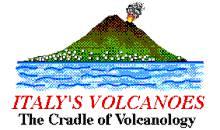|
Archived Etna news
|
Do you plan to visit Etna
in the near future?
Check the weather
forecasts for the Etnean area!
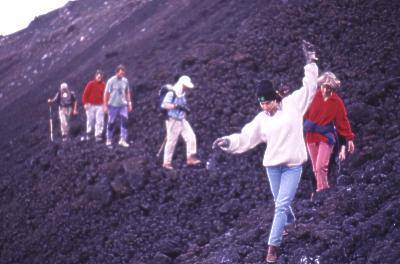
The narrow path leading to the ephemeral effusive vents across recent lavas on the steep Valle del Bove slope. Photo taken on 19 May 1999.
20 May 1999
|
WARNING: Access to the summit craters can be DANGEROUS. Weather conditions are often unstable, and there is always a risk of sudden explosive activity from the summit craters. As effusive activity from the fissure near the southeastern base of the SE Cone is gradually decreasing, renewed activity may be expected from the craters soon after the cessation of the lava outflow. Any person who enters the area beyond the Torre del Filosofo mountain hut (2900 m elevation) goes at his/her own risk and is not covered by any insurance in case a rescue operation (e.g., with helicopters) is necessary. The same is true for those who try to get close to the still-active effusive vents on the Valle del Bove slope. |
To the great delight of both mountain guides and tourists,
effusive activity has resumed after about one month in an easily accessible
area, about 100 m downslope from the hornitos which formed during the
first weeks of the effusive activity initiated on 4 February.
A luminous spot was sighted on Saturday (15 May) evening by Giuseppe
Scarpinati (Italian delegate of the Association
Volcanologique Europèenne, Paris) in the area of the hornitos
when he observed the area with binoculars from his home in Acireale.
Earlier that day, Harry Pinkerton (Environmental Sciences Division,
University of Lancaster) and Sonia Calvari (Istituto Internazionale
di Vulcanologia, Catania) had worked in the same area and noted no active
lava. The next day (16 May), lava was extruded from three small vents
at low effusion rate. The rate of lava emission increased during the
following two days, and a larger effusive vent became active about 20
m upslope from the original three vents, feeding sluggish flows that
advanced across older lavas in the northern part of the flow-field formed
since 4 February. It was noted that the effusion rate at the ephemeral
vent on the western slope of the Valle del Bove apparently decreased
somewhat in response to the new effusive activity near the original
eruptive fissure of 4 February.
On 19 May, Boris Behncke, Antonella Lentini, Mariangela Porravecchio
(IGGUC), Valentina Giambarresi (Catania University), Massimiliano Rindone
of Torino, and two groups from France and the Netherlands visited Etna's
summit area and the effusive vents at the base of the SE Cone and on
the western slope of the Valle del Bove. A part of this group climbed
to the summit of the SE Cone from its southeastern base. Since the previous
visit by Behncke on 12 May, no significant changes had occurred at the
crater of the SE Cone except that all emissions of vapor from the obstructed
crater floor had ceased. The crater floor was found to lie at a depth
of about 70 m below the western rim, and the crater walls are vertical
in most places. Some large blocks on the southern crater rim have detached
from the outer rim and are prone to fall into the crater in the future;
however, these blocks are in the same position as one week earlier.
Fumarolic activity is occurring from cracks between these blocks and
the outer crater rim, and from numerous smaller fissures mostly in the
southern crater rim and below the western lip of the crater, as well
as from a collapse pit formed on the southeastern crater rim some time
after the 4 February paroxysmal episode.
While the group stayed on the summit of the SE Cone, ash emissions occurred
from Bocca Nuova and NE Crater, producing dilute plumes that rose about
100-150 m above the respective crater rims. Rumbling sounds coming from
the direction of the Voragine or (less likely) NE Crater. Those of the
group who had remained in the area of the hornitos at the base of the
SE Cone heard the noise as well. No visible emissions were associated
with the noise, and no further were heard when everybody had returned
from the summit of the SE Cone to the area of the hornitos.
The newly formed effusive vent some 80-100 m below the hornitos produced
a lava flow about 0.8 m wide at a distance of several meters from the
vent, which curved eastward and then northeastward. The vent lay in
a much larger, drained channel about 3 m wide in its central portion,
which apparently had been active at the beginning of the effusive activity
in this place. The shift of the currently active vent from the head
of the larger channel (where lava is coming out of a tube) downslope
was evident in the form of a ridge which had been built by a series
of crusted-over effusive vents, a feature visible at many effusive vents
and one of the dominant processes of lava tube formation (growth by
downflow accretion of crust at the effusive vent). The emission of lava
was frequently accompanied by strong degassing producing a hissing noise,
indicating that the lava here was more gas-rich than the lava issuing
about 200 m downslope from the ephemeral vent on the Valle del Bove
slope. Some 20 m downslope from this active effusive vent, one of the
initial three vents (of 16 May) was still extruding small amounts of
bulbuous lava, forming a tumulus. The tumulus grew by lava pushing from
below and being squeezed through cracks in the tumulus surface - similar
to the so-called "inflation cracks" (an expression introduced
recently on the Kilauea
updates page of the Hawaiian Volcano Observatory). Inactive "inflation
cracks" partly filled with sausage-like, bulbuous lava were present
around the active tumulus.
| 19 May 1999 photos | ||
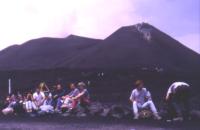 |
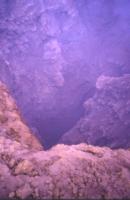 |
|
|
Left:
The SE Cone seen from south, seen from Torre del Filosofo at
a distance of about 1 km. Part of the people in the foreground
are the group who is mentioned in the text.
Right: View of the bottom of the SE Crater from southwestern rim, showing complete absence of gas emission. |
||
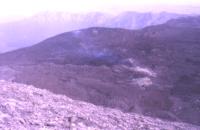 |
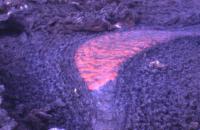 |
|
|
Left:
Panoramic view from upper southeastern flank of SE Cone of the
lava flow-field emplaced since 4 February. Bluish steam is marking
the newly active surface flow. Click
here for an annotated version of the enlarged image: 1=Upper part
of 1991 fissure; 2=Hornitos; 3=newly active effusive vent. Lava
erupted during the 4 February paroxysmal episode are outlined
in orange while the lava produced since the evening of 4 February
is outlined in red. Broken line in brown indicates pre-eruption
Valle del Bove rim. Note that the flow outlines have been corrected
in comparison to a similar image of 12 May (see 12 May photos
below).
Right: Ephemeral effusive vent located about 80-100 m downslope from the hornitos. |
||
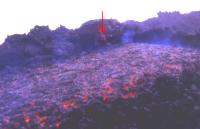 |
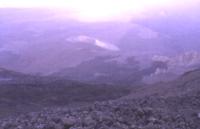 |
|
|
Left:
View towards the newly active ephemeral vent. Arrow points to
the lava tube above this vent (the area of the lava tube has been
contrast-enhanced for better visibility.
Right: View from the western rim of Valle del Bove onto the valley floor (compare to similar 12 May image). Click here for an annotated version of the enlarged image. |
||
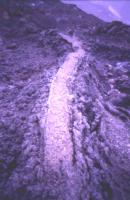 |
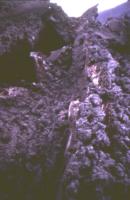 |
|
|
Left:
Eastern side of the tumulus collapsed on 12 May. This narrow (about
0.3 m) lava flow has built a rampart instead of flowing in a channel.
Right: View of vent 1 on the northern side of the collapsed tumulus. Emptied flow channel is visible in lower part of the photo while the tube which fed the vent is visible at upper left. |
||
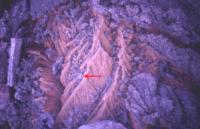 |
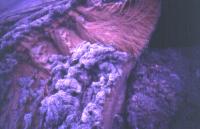 |
|
|
These
two photos show enigmatic lava structures at vent 2 on the eastern
side of the collapsed tumulus (arrow in left image points to lense
cap about 3 cm in diameter). Two types of lava are visible: brown,
relatively dense lava with a ripply texture to which paches of
dark, scoriaceous, fresh-looking lava is attached. Brown lava
may have been subjected to heat as newer lava flowed across it,
and the surface texture may be a result of shearing. Similar structures
can be found on the sides of lava channels.
|
||
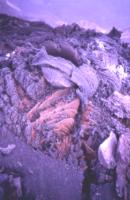 |
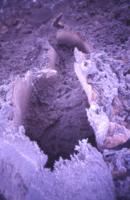 |
|
| Left:
This is what remains of vent 2 (the one which extruded lava like
toothpaste on 12 May, shortly before the tumulus collapse). Note
that part of the lava "bulge" at the vent is still present;
evidently a crust formed on it before its inner part drained away. Right: A closer look at vent 2 and the drained lava channel below it. |
||
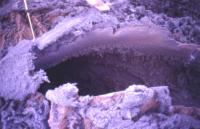 |
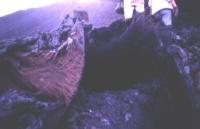 |
|
|
Left:
Side view of vent 2, showing part of the vent's interior and remains
of the lava skirting the vent.
Right: View into vent 2 from upper part of the lava channel below it. |
||
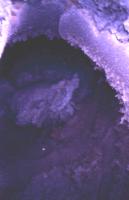 |
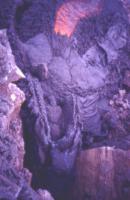 |
|
|
Left:
The emptied cavity below vent 2, and a small mass of lava extruded
on the cavity floor just before the vent was entirely cut off
from lava supply as the tumulus behind it collapsed.
Right: A view from the western side of the collapsed tumulus into the collapse depression formed on 12 May, showing the complex evolution of the ephemeral effusive vent within it. At an early stage, lava issued from the vent at the bottom of the photo, but the vent then shifted away from its original location, leaving a trace of partially collapsed vent remainders and bulbuous lava masses. Width of the area in the photo is about 3-5 m. |
||
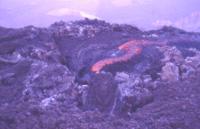 |
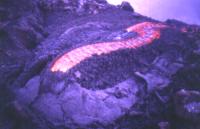 |
|
|
Left:
Full view of the tumulus collapsed on 12 May, and lava flowing
from the depression left by the collapse; view is to the east.
Right: Ribbon of lava flowing from 12 May collapse depression. Note smooth (pahoehoe) lava forming a ribbon about 1 m wide at right. |
||
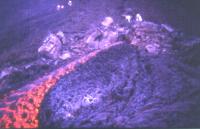 |
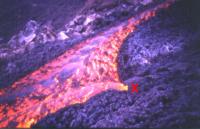 |
|
|
Left:
View from eastern side of the 12 May collapse depression, and
the active lava coming out of it. Persons in upper part of the
photo give scale.
Right: Small secondary effusive vent (marked by the letter "x") giving a minor flow that joins the main flow coming from the collapse depression. |
||
The visit to the ephemeral vent on the Valle del Bove
slope was highly instructive regarding the properties of effusive vents
and lava channels. Lava was still flowing from two vents on the floor
of the depression formed during the collapse of the large tumulus observed
on 12 May (see paragraphs and photos of the 13 May update), feeding
flows that descended southeastward within the limits of the flow-field
emplaced since 4 February. Flow fronts did not extend to the Valle del
Bove floor. Four or five well-channelized flows about 1 m wide were
moving down the slope; towards their fronts two of these flows were
seen to thicken and broaden to 2-3 m height and 5 m width; it was most
curious to see one of these flow fronts advance on top of another, well
channelized flow, a process that caused frequent collapse of incandescent
blocks from the front of the upper flow due to the movement of the lower
flow.
The floor of the depression left after the tumulus collapse of 12 May
was partially covered with new lava, - most of this being aa with one
small lobe of very smooth pahoehoe - and like at the effusive vent near
the hornitos, the main effusive vent had shifted, by downslope accretion
of lava crust, about 2 m from the original source at the western side
of the collapse depression. A second effusive vent some four to five
meters downflow produced a small volume of lava that joined the main
flow.
Investigation of what remained of the collapsed tumulus revealed that,
surprisingly, the two effusive vents that had been observed on 12 May
shortly before the tumulus collapsed, had not been completely destroyed
by that event. One of these vents, vent 1, lay on the northern side
of the tumulus, and while still active, it had fed lava directly into
a well-defined channel. The other vent (2) on the eastern side of the
tumulus had squeezed out lava much like toothpaste, which then had spilled
down the steep eastern face of the tumulus, and no channel was evident
in the upper part of this flow. Both vents were instantaneously cut
off from lava supply as the tumulus collapsed, and when the area of
vent 1 was observed shortly thereafter, lava was still slowly draining
from the flow channel. Observation one week later revealed that the
channel had completely drained, its depth being about 1.5 m (compared
to a width of 0.8-0.9 m). This is much higher depth-width ratio than
in most other lava channels on Etna and many other volcanoes, but normally
lava channels are not drained as completely as in this case since the
supply of lava decreases gradually, allowing some of the lava to remain
and "freeze" on the channel floor. The depth of active lava
channels has been quite a bit of a mystery until now, and the observations
near the collapsed tumulus may provide valuable information about the
parameters of lava channels.
Vent 2, one week after the abrupt cessation of its activity, had a completely
different aspect. Its mouth was skirted by thin rims of lava which are
remainders of the surface "toothpaste" squeezed out of the
vent until the tumulus collapse. Different from vent 1 where lava had
been fed from a gently sloping tube directly into a channel, vent 2
was a roughly circular hole which was open towards the downslope side,
and evolving into a flow channel - this one being throroughly drained
as well - that had been hidden under the lava when observed shortly
before the tumulus collapse. Like at vent 1, this flow channel was deeper
than wide. It has to be noted that the vent 2 channel is on much steeper
terrain, but this apparently had no effect on the depth and width of
the flow channel. The vent itself, while being about 1.5 m wide at its
rim, then widened at depth to a subcircular cavity from whose floor
some bulbuous lava had oozed, probably, at some stage of the tumulus
collapse. This indicates that there had actually been a kind of a lava
pocket at very shallow (that is, about 1 m) depth.
Vent 2 was surrounded by peculiar lava features which are difficult
to explain. There was something like a "basal" lava type,
of chocolate brown color, and with a very smooth, but ripply surface,
onto which patches of black, scoriaceous lava were attached. Much of
these features are almost certainly related to the frequent and rapid
shifting of the locus of active lava extrusion, and the shearing of
actively extruding lava along solidified lava on the vent or flow channel
walls. Much analysis is needed to fully understand the genesis of this
peculiar association of brown, smooth and black, scoriaceous lava, but
it will probably teach much about the dynamics of flow in and near an
effusive vent.
To return to a more general perspective, the rate of lava effusion appears
to remain fairly stable since at least three weeks; there may have even
been a slight increase in the effusion rate, causing the renewed appearance
of active lava high up in the flow-field. The effusive activity, 108
days after its beginning, is far from being as vigorous as during its
first six weeks, but it does not show any sign of ending soon, so that
lava flows may be expected to continue for weeks to come.
visitors counted since 12 February 1999
(more than 10,000 during the first 3 weeks!)
FastCounter
by LinkExchange
Page set up on 27 May 1997, last modified on 26 May 1999
